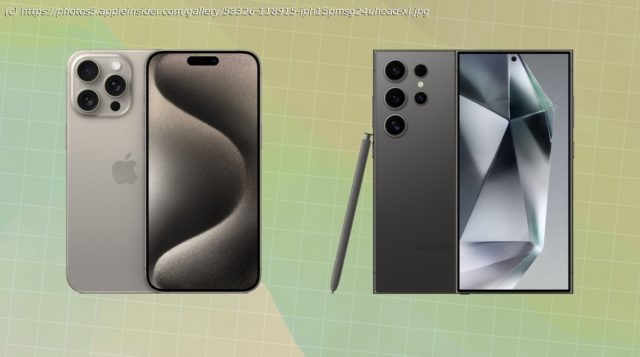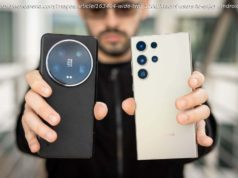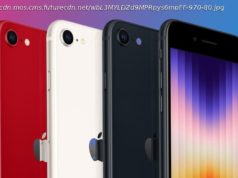Samsung’s top-specification new release, the Galaxy S24 Ultra, adds super-sized specifications to the range. Here’s how it fares when compared against Apple’s top-tier smartphone, the iPhone 15 Pro Max.
Samsung’s top-specification new release, the Galaxy S24 Ultra, adds super-sized specifications to the range. Here’s how it fares when compared against Apple’s top-tier smartphone, the iPhone 15 Pro Max.
Samsung’s introduction of the Galaxy S24 Ultra as part of its Unpacked event is the South Korean tech firm’s flagship release. With the biggest screen and the best camera capabilities of the range, the S24 Ultra offers a lot to consumers wanting a great smartphone.
As the main rival to Apple’s iPhone range, the S24 Ultra has to compete directly against the iPhone 15 Pro Max, Apple’s own largest and most powerful smartphone.
The battle for the high-end is usually a closely fought one, and for this year’s fight, it’s as close as it has ever been.
iPhone 15 Pro Max vs Samsung Galaxy S24 Ultra – SpecificationsiPhone 15 Pro Max vs Samsung Galaxy S24 Ultra – Physical dimensions
Already on the market, the iPhone 15 Pro Max has enjoyed a number of months to itself as the best option on the market for anyone who likes big smartphones. At 6.29 inches long by 3.02 inches wide and 0.32 inches thick, it’s a hefty size made for big hands.
Samsung’s response in the Galaxy S24 Ultra is to go even bigger.
At 6.39 inches by 3.11 inches, it’s a bit longer and wider, which makes sense given its use of a slightly larger display. At 0.34 inches thick, it’s got a bit more volume than Apple’s smartphone.
These size differences also translate into variations in weight. Apple’s 7.81-ounce iPhone 15 Pro Max is a fairly dense device, but then Samsung decided to make its smartphone 8.18 ounces.
Samsung S24 UltraiPhone 15 Pro Max vs Samsung Galaxy S24 Ultra – Display
The iPhone 15 Pro Max’s screen is a 6.7-inch Super Retina XDR OLED panel, sporting a resolution of 2,796 by 1,290, and a pixel density of 460 pixels per inch. Apple also made it an always-on screen that takes advantage of ProMotion support, so it can go as high as 120Hz, or low enough to stay on without burning energy.
Samsung equips its Galaxy S24 Ultra with a 6.8-inch Dynamic AMOLED 2X display, making it a tenth of an inch larger. Its resolution of 3,120 by 1,440 pixels and its size means it has a pixel density of 505ppi, a lot higher than the iPhone.
Samsung also has its own variable refresh rate between 120Hz and 1Hz, branded as SuperSmooth.
The Pro Max has a maximum brightness for typical content at 1,000 nits, rising to 1,600 nits of peak brightness for HDR content, and 2,000 nits peak for outdoor usage. At its peak, Samsung’s always-on offering can push out 2,600 nits.
Both Apple and Samsung put a hole in the display to lodge their respective cameras, but Apple goes out of its way to try and disguise the hole with the Dynamic Island UI elements.
iPhone 15 Pro Max vs Samsung Galaxy S24 Ultra – Cameras
The iPhone 15 Pro’s triple camera setup is helmed by a 48-megapixel f/1.78 aperture Main camera, which has a second-gen sensor-shift optical image stabilization system. Along with an increase in the default image size from 12MP to 24MP, Apple also creates a fictional fourth camera by cropping the Main image.
The Ultra Wide is a 12-megapixel version with an f/2.2 aperture and a 120-degree field of view, just like the iPhone 15 Pro. The Telephoto camera differs, because while it has a 12MP sensor with an f/2.8 aperture, it also has a tetraprism lens with 3D sensor shift OIS, which enables a 5x optical zoom-in, and a maximum digital zoom of 25x.
Apple’s work in computational photography reappears in this generation, combining Deep Fusion with the Photonic Engine, with other features including Smart HDR 5, Portrait Lighting, Focus and Depth Control portraits, a LiDAR-supported Night Mode, and Apple ProRAW.
The Pro models also benefit from video upgrades, including the ability to record ProRes 4K 60fps footage directly to a USB-C drive. It also introduces log video recording and Academy Color Encoding System support.
Samsung trumps Apple in using four actual camera sensors, with wildly different specifications.
The standard Wide camera has a 200MP sensor with an f/1.7 aperture, laser autofocus, and OIS.






